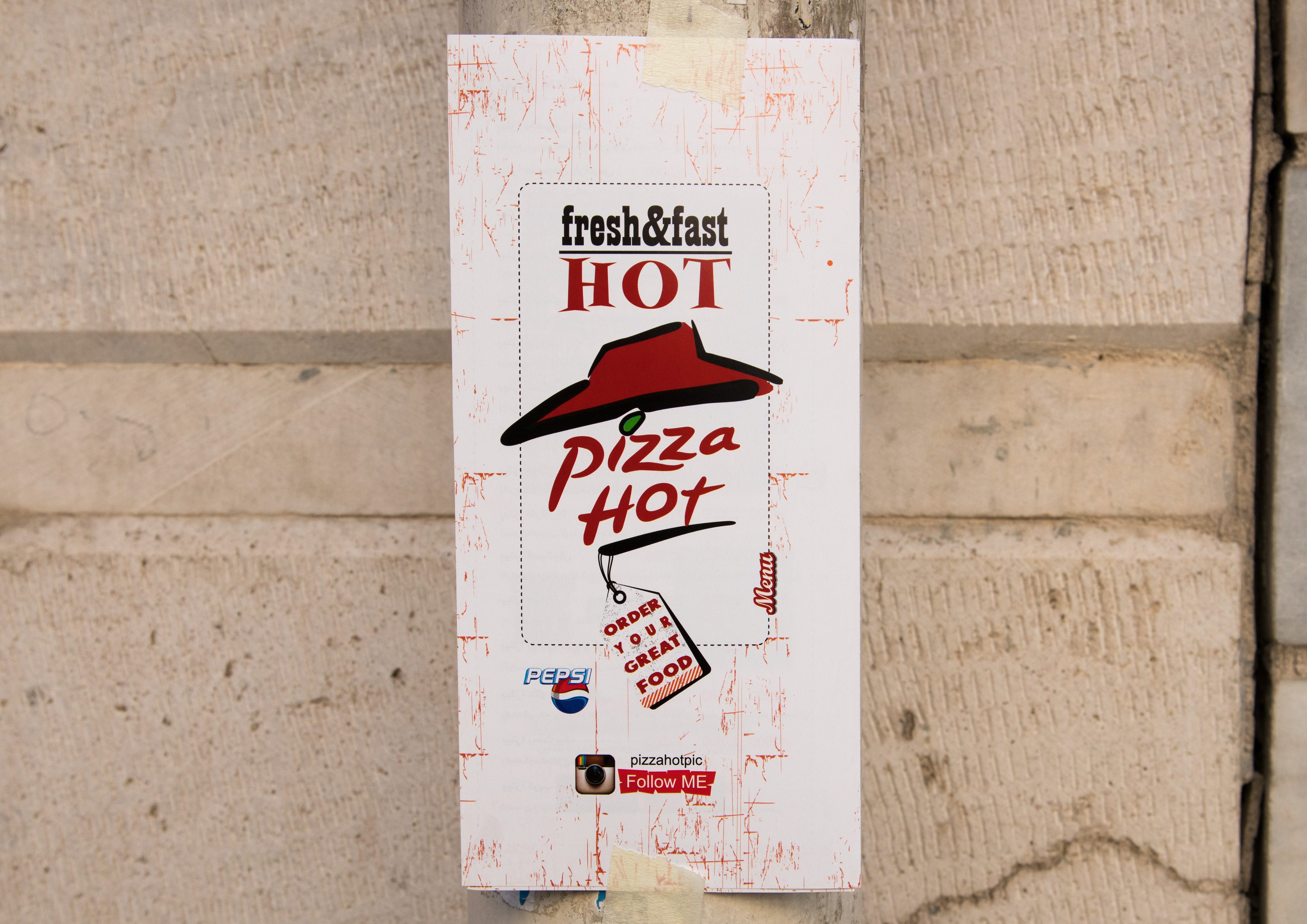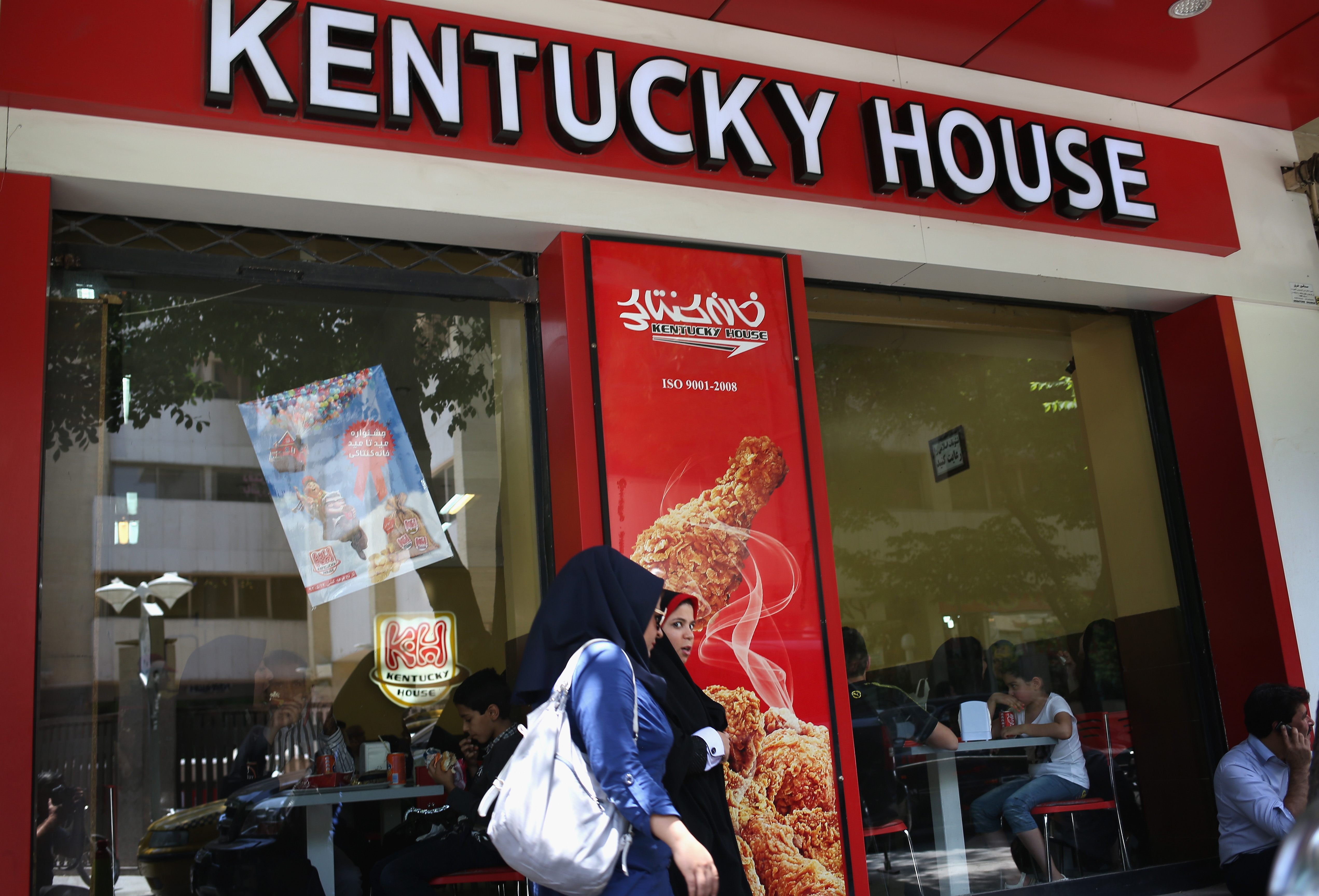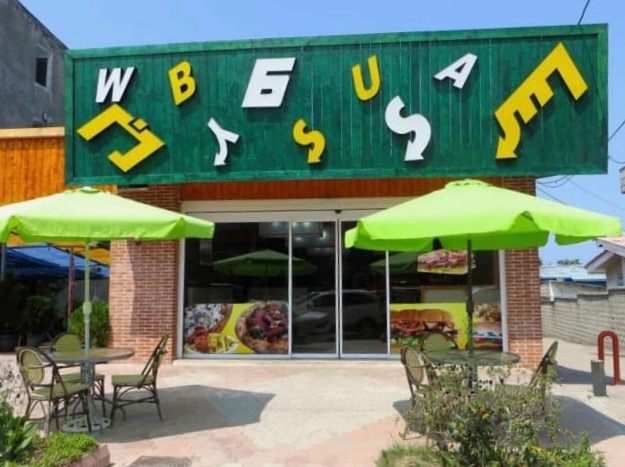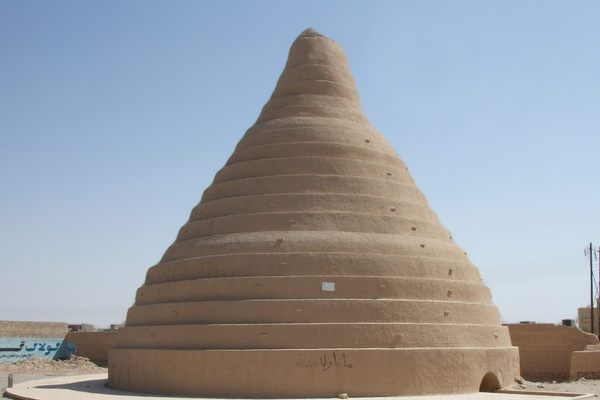How Bootleg Fast Food Conquered Iran
Mash Donalds, Sheak Shack, and Pizza Hat are very popular.

Forty years ago, opening a KFC franchise in Tehran was a sign of progress. Today, it’s against the law.
Before the 1979 revolution—before religious clerics took control of the country—Iran’s capital, Tehran, was a cosmopolitan city that glittered with Western influence: secularism, mini-skirts, and fast food chains such as McDonald’s and Kentucky Fried Chicken. But the new ruler, Ayatollah Ruhollah Khomeini, pushed a return to Islamic values and removing American influence. And so, women were forced to cover, Western texts were removed from schools, and American franchises were suddenly contraband.
In cutting its Western alliance, Iran became an isolated nation focused on traditionalism and hounded by morality police. Beneath the surface, though, most Iranians maintained an appreciation for Western culture, whether that meant banned literature or McDonald’s-style burgers. If there was one thing the government couldn’t suppress, it was taste. That’s why Iran is now home to dozens of knockoff franchises, from Mash Donald’s to Sheak Shack, that have taken advantage of hostility toward American fast food to serve dangerously delicious burgers, fries, and burritos. You can find the golden arches in Iran; they just have no official connection to McDonald’s.

In the 1970s, Tehran was urbane and opulent. But it was also corrupt. The Iranian government had essentially been under Western control since 1953, when democratically elected Prime Minister Mohammad Mosaddegh was ousted in a coup organized by the United States and Britain. Like many Middle Eastern affairs, oil fueled the conflict—Mosaddegh tried to audit and then nationalize the Anglo-Iranian Oil Company, so they retaliated. The CIA and MI6 planned the removal of Mosaddegh from office, and the role of the monarch (Shah) evolved from ceremonial to totalitarian (and loyal ally).
As the Shah’s grip on Iran tightened, dissenters mysteriously disappeared, and anyone who resisted got a visit from the secret police.* Many fled, were imprisoned, or worse. Under the leadership of high priest Khomeini, a swarm of people decided they’d had enough and revolted. Bloody demonstrations followed, and in 1979, the Shah left in search of exile and cancer treatment. Khomeini became Supreme Leader of Iran.
The Revolution and the change that followed created both more tension with the United States and a sizable Iranian diaspora in the West. Many secular Iranians left the new theocracy for Europe, Canada, and the United States. Others fled what followed: The arrests, inflation, and violence, including a certain hostage crisis at the American Embassy; tightened borders and U.S.-led sanctions; and a bloody, eight-year war with Iraq (who the United States backed) in which young boys were drafted and bombs rattled major, historic cities. Years later, the exodus would help expose those left behind to the rest of the world.
Iran’s government became less rigid in the 1990s, after Khomeini’s death, and citizens grew gutsier about flouting some strictures on Western ways. Women wore bright lipstick accented by veils, with sandals peeking out below mandated overcoats. And Iranian entrepreneurs, inspired by fast food’s success abroad, opened imitations in Tehran. (They later expanded to medium-sized cities.)

Despite the government’s efforts, Iranians maintained contact with the West through satellite television and visits from the diaspora and their American-born children. Fast food, then, became another way Iranians could experience the outside world.
“Iranians got tired of limited food options and were looking for a quick bite to eat,” says Holly Dagres, Iranian-American journalist and analyst and curator of “The Iranist” newsletter. “Fast food seemed the way to go, especially since many Iranians travel to Dubai and try American fast food franchises there.”
At the start of the fast-food wave, these restaurants were seen as places of status. Dagres recalls that Super Star, a Carl’s Jr. knockoff, was the place to be seen in the ‘90s. “Not every Iranian could afford a burger that cost almost as much as a kabob dish,” she says.
Over the next few decades, the copycat trend snowballed into outright saturation: Mash Donalds, Boof Burger, Subways, Sheak Shack, Pizza Hat. Menu item names, such as Dahbel Dahn (KFC Double Down) and Wooper, were adjusted to fit the Persian vernacular’s rich vowels. In other cases, traditional ingredients met Western formats to create one-of-a-kind dishes, such as lavash-wrapped burritos stuffed with jujeh (chicken) kebab, grilled vegetables, saffron rice, and yellow raisins.
“Fast-food in Iran is very much from other countries and cultures,” says Mahan Kazemi, a fast-food enthusiast based in Tehran. Despite the people’s appreciation for Western culture, sanctions, tariffs, and government hostility deprive Iranians of famous brands and international food: They can’t open a bona fide KFC franchise or access the Colonel’s fabled blend of herbs and spices. (Although Coca-Cola and Pepsi are widely available again, via subsidiaries and local production, after a Bill Clinton-era ban.) Imitation through fast food, then, is their answer.
In most countries, these restaurateurs would have to worry about lawsuits from Chipotle, Shake Shack, and KFC. But Iran’s murky relationship with the United States gives these entrepreneurs some leverage.
The legal institutions do exist for McDonald’s lawyers to shut down Mash Donalds. Iran may not belong to the World Trade Organization, but Iran’s Patent and Trademark Office is part of the World Intellectual Property Organization and the Madrid Protocol, and Iran has special courts that handle these cases.
“Nothing in the existing sanctions prevents a U.S. company from registering a trademark in the Islamic Republic,” says David Jacoby, an intellectual property partner at New York’s Culhane Meadows law firm. “In fact, the U.S. Government’s Office of Foreign Assets Control has a general license under which American companies can take steps to protect their intellectual property rights in Iran.” In 2010, for example, Baskin-Robbins managed to shut down five bootleg franchises.
But such cases are rare, as the dysfunctional Iranian-American relationship makes enforcing intellectual property in Iran unfulfilling for fast food chains. Culhane Meadows partner Felicia Traub describes Iran as unfamiliar trademark territory. “For starters, Iran might not even allow the registration of every mark that might have qualified for registration elsewhere.” Traub cites the example of the Islamic Republic refusing trademarks that include portraits of women. That means no trademark for the Columbia Pictures logo and no trademark for Aunt Jemima pancakes.
Jacoby explains that given the unfamiliar legal terrain and lack of diplomatic ties to help navigate legal missteps, companies are inclined to devote their limited time and money to enforcing trademarks in bigger markets. As Dagres sums it up: “Why go through the trouble of pushing for a trademark infringement when your company doesn’t have a presence in the country to begin with?”
Instead, the larger concern for the Iranians behind Sheak Shack and Subways is the Iranian government. Iran’s imitation fast food chains, Dagres says, are “the symbol of American cultural imperialism, which was one of the driving forces of the 1979 revolution.” Authorities can shut them down for promoting gharbzadeghi, a Persian term for “westoxification.” In 1994, for example, the Basij, a parliamentary, volunteer-based militia established after the Revolution, famously threatened a McDonald’s imitator with arson. The restaurant shut down within two days. More recently, in 2015, when a Turkey-based imitator of KFC opened in Tehran, it was shut down due to the “grave danger” it posed.
In the end, the restaurant owners play a balancing act: imitating Western chains enough to draw Iranians who want to try those brands, but not so closely that the government accuses them of corrupting and Westernizing the country.

On weeknights, the food courts at Tehran’s Palladium Mall buzz with customers. Located on the famous shopping center’s first and third floors, the courts are dotted with modern yellow and lime green chairs and towering fake palm trees.
On trays and counters, American staples and pizza cohabitate with tostadas, chicken katsu, and Irish breakfasts. People wait up to 10 minutes in line, soaking up the hype. Several of these chains aren’t even knockoffs—they’re original concepts.
“There’s always a fast food restaurant popping up somewhere,” Dagres says. Many Iranians see fast food as a novelty that enlivens nights out, or they prefer “catering” their parties with take-out burgers and burritos to spending hours in the kitchen.
“Iranian franchises like Boof and Apache compete with each other, but their bigger concern is if tomorrow an original Western franchise opens up,” Dagres says. “If McDonald’s opened up, Iranians would likely never go back to an Iranian franchise. Not necessarily because McDonald’s tastes better, but because it’s trendy and a Western franchise.”
Iran has a long way to go before it can repair its relationship with the West, and that depends on political will on both sides. In the meantime, ordinary Iranians just want to get a bucket of fries and enjoy the foods they crave most.
*Correction: This post has been changed to clarify the balance of power after the 1953 coup.
Gastro Obscura covers the world’s most wondrous food and drink.
Sign up for our regular newsletter.


























Follow us on Twitter to get the latest on the world's hidden wonders.
Like us on Facebook to get the latest on the world's hidden wonders.
Follow us on Twitter Like us on Facebook